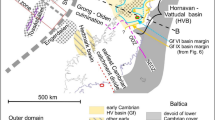Abstract
As integral parts of du Toit’s (1927) “Samfrau Geosyncline”, the Sauce Grande basin–Ventana foldbelt (Argentina) and Karoo basin–Cape foldbelt (South Africa) share similar paleoclimatic, paleogeographic, and paleotectonic aspects related to the Late Paleozoic tectono-magmatic activity along the Panthalassan continental margin of Gondwanaland. Late Carboniferou-earliest Permian glacial deposits were deposited in the Sauce Grande (Sauce Grande Formation) and Karoo (Dwyka Formation) basins and Falkland–Malvinas Islands (Lafonia Formation) during an initial (sag) phase of extension. The pre-breakup position of the Falkland (Malvinas) Islands on the easternmost part of the Karoo basin (immediately east of the coast of South Africa) is supported by recent paleomagnetic data, lithofacies associations, paleoice flow directions and age similarities between the Dwyka and the Lafonia glacial sequences. The desintegration of the Gondwanan Ice Sheet (GIS) triggered widespread transgressions, reflected in the stratigraphic record by the presence of inter-basinally correlatable, open marine, fine-grained deposits (Piedra Azul Formation in the Sauce Grande basin, Prince Albert Formation in the Karoo basin and Port Sussex Formation in the Falkland Islands) capping glacial marine sediments. These early postglacial transgressive deposits, characterised by fossils of the Eurydesma fauna and Glossopteris flora, represent the maximum flooding of the basins. Cratonward foreland subsidence was triggered by the San Rafael orogeny (ca. 270 Ma) in Argentina and propogated along the Gondwanan margin. This subsidence phase generated sufficient space to accommodate thick synorogenic sequences derived from the orogenic flanks of the Sauce Grande and Karoo basins. Compositionally, the initial extensional phase of these basins was characterized by quartz-rich, craton-derived detritus and was followed by a compressional (foreland) phase characterized by a paleocurrent reversal and dominance of arc/foldbelt-derived material. In the Sauce Grande basin, tuffs are interbedded in the upper half of the synorogenic, foldbelt-derived Tunas Formation (Early–early Late? Permian). Likewise, the first widespread appearance of tuffs in the Karoo basin is in the Whitehill Formation, of late Early Permian (260 Ma) age. Silicic volcanism along the Andes and Patagonia (Choiyoi magmatic province) peaked between the late Early Permian and Late Permian. A link between these volcanics and the consanguineous airborne tuffs present in the Sauce Grande and Karoo basins is suggested on the basis of their similar compositions and ages.
Similar content being viewed by others
Author information
Authors and Affiliations
Additional information
Received: 10 May 1996/Accepted: 2 July 1997
Rights and permissions
About this article
Cite this article
López-Gamundí, O., Rossello, E. Basin fill evolution and paleotectonic patterns along the Samfrau geosyncline: the Sauce Grande basin–Ventana foldbelt (Argentina) and Karoo basin–Cape foldbelt (South Africa) revisited. Geol Rundsch 86, 819–834 (1998). https://doi.org/10.1007/s005310050179
Issue Date:
DOI: https://doi.org/10.1007/s005310050179




